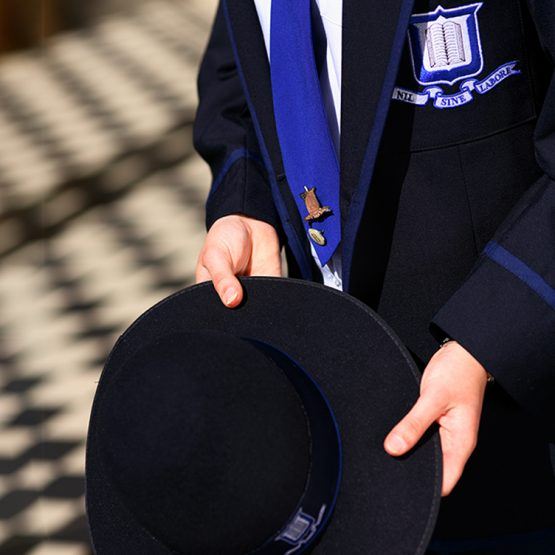Mr Andrew Pennay, Director of Creative Arts
No one is sure who first supposed ‘talking about music is like dancing about architecture’. Was it Elvis Costello, Frank Zappa, Thelonious Monk, or someone much older? Despite the phrase’s unclear provenance, the sentiment is timeless in its concern for the subservient roles that arts theory, criticism and analysis play in relation to arts practice.1 The concern rings true for many of our learners who find a level of discomfort in critiquing music, art and drama owing to a common disease: there is a threat that as we look under the hood, the magic (and the epicurean pleasure of an unpacked experience) is stolen.
In short, this presents as a ‘prac versus theory’ debate. What is the benefit in responding to other people’s work when we might prefer spending time making our own? This is an immediate concern for us in the arts classroom, given the extent to which we discuss, analyse and debate existing creative works—as well as of making and performing new ones—in the current era. Following a desktop review of relevant curriculum frameworks2, QCAA chose to culminate current Music, Visual Art and Drama senior courses with final written examinations where students respond to arts stimuli rather than making bodies of original work.
Aristotle played a great part in categorising arts experiences (and everything, of course), broadly believing that humans undertake three basic activities: doing; making; and thinking3. Arts-specific doing (praxis) and creating (poisis) are integrated well in a modern arts classroom and enjoyed variously through composing, performing, devising, acting, dancing and manipulating art materials. Aristotle’s concept of thinking (theoria) plays out well in an arts classroom as well—far beyond training future musicologists, art critics, dramaturgs—as we inform our arts practice and improve our skills as an arts-literate audience. Together, these arts learning experiences culminate in a colourful dance about architecture, a ‘practical wisdom’ that is deep and essential.
Because this critical thinking is so central to our curriculum practices (categorised broadly as Responding in our national curriculum documentation4), we would do well to employ a framework to help our children and ourselves unpack the art surrounding us. I have become particularly drawn to a specific routine for structuring the analysis of creative works5 by having students consider five interrelated layers: narrative; connections; dynamic; mechanical aspects; and the aesthetic appeal of a work.
Although we could look infinitely closely at any work of art to examine these layers for this article—I initially considered Vincent van Gogh’s The Starry Night, Chuck Close’s portrait of Mark, Eugène Ionesco’s absurd play, The Chairs, and Beyoncé’s film, Lemonade—it gave me particular joy to unpack Taylor Swift’s latest album, Folklore, in Music Extension lessons last week. This body of work was penned and produced quickly with collaborators over the past few months of isolation, and to my ear, the resultant flavour is mature and intriguing. What follows are some of the notes from our in-class wonderings:
Narrative: In class, we systematically consider the story, back story, hidden story and message of the album. Naturally, the same-day surprise announcement and release of Folklore is our first point of conversation, but deeper discussion follows about quarantine albums, collaborations and even Swift’s tumultuous dealings with Kanye West.
Connections: As we listen, the girls identify ways that Swift connects to them personally. They search for connections to her earlier work, too. I push them to consider ways that Folklore connects with other works outside the genre. How does the album relate to history? Was she directly influenced by Franz Schubert? What would it have sounded like if Swift wrote this album 100 years earlier amidst the Spanish Flu pandemic?
Dynamic: We go searching for things that shift and move as we listen. Where and how does she employ surprise? What about tension? How might we analyse the change of emotion from verse to chorus? By now, the students hum under their breath as they try to attach solfa, numbers, letter names and rhythm symbols to the music they hear. Did she really start the whole album with a cadence akin to a hymn-like ‘Amen’? The girls struggle to find the key of the song ‘Cardigan’ until the chorus, and we discuss the impact of delayed resolution in communicating the meaning of the lyrics.
Mechanical: As we listen to excerpts again, more deeply this time, the girls identify detailed techniques, structures, compositional methods and symbols that give Folklore its characteristic feel. Soon enough, we will develop a histogram to analyse the relative predominance of different chords in the album. The girls go searching for the best examples of prosody they can find in Swift’s lyrics, reporting back eagerly.
Aesthetic: Arguably, this is a student’s favourite layer to observe, so they are pushed for more evidence in their responses. Does Taylor Swift actually offer anything new or unusual? When, specifically, is her mastery most on display? What, specifically, is the appeal as we listen to moments from each track? Beyond the pretty, the powerful and the perplexing, what is the takeaway for the audience?
As we as parents, teachers and students circle through these five layers of thinking together, something crystallises invariably: no single aspect of an art work exists by itself. The narratives, connections, dynamics, mechanics, and aesthetics presented by Taylor Swift are beautifully and craftily interwoven. This routine we employed is a stepping-off point (a conversation starter) and one you might be practically wise to use when considering Botticelli, Beethoven, Brecht, or Beyoncé in the car.
From such critical thought-excursions, Girls Grammar teachers assist our girls to go far beyond a ‘prac versus theory’ mindset, instead offering a window into deeper and more prolonged artistic inquiry and a residual practical wisdom that students can carry with them for life. If we truly want our students to know stuff, and do stuff with what they know, learning to dance about architecture may in fact be the biggest gift we can offer the arts learners in our care.
1 Mottier, V. (2009). “talking about music is like dancing about architecture”: Artspeak and pop music. Language & Communication – Lang Commun, 29, 127-132.
2 Gattenhof, S., & Desuanni, M. (2016). Arts literature review: Senior syllabus redevelopment. The State of Queensland (Queensland Curriculum and Assessment Authority), Australia.
3 Potur, A., & Sevinç Kayıhan, K. (2011). Theoria, praxis, poiesis: A continuum scheme. Archnet-ijar, 5
4 Key ideas. (n.d.). Retrieved from https://www.australiancurriculum.edu.au/f-10-curriculum/the-arts/key-ideas/
5 Layers: A thinking routine from Project Zero, Harvard Graduate School of Education. (n.d.). Retrieved from https://pz.harvard.edu/sites/default/files/Layers.pdf.



